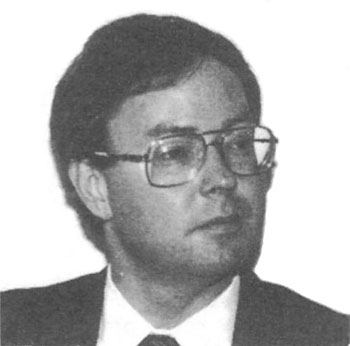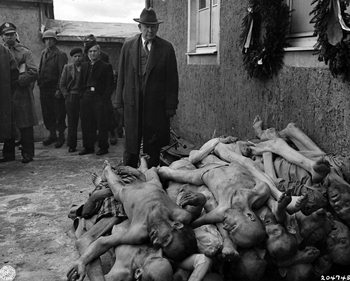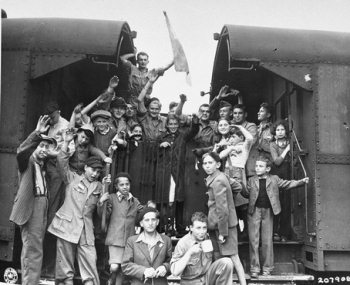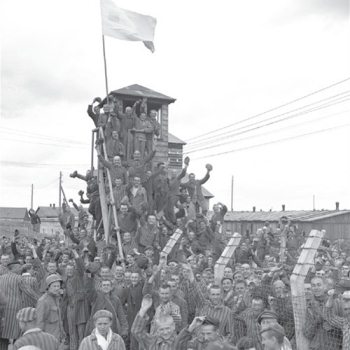The Liberation of the Camps: Facts vs. Lies
Theodore J. O'Keefe, educated at Harvard University, is the author of numerous published articles, essays and reviews on historical and political subjects. For some years he served as editor of this Journal.
A version of this essay is available, in convenient leaflet form, from the IHR at the following prices, postpaid: Ten copies for $2; Fifty copies for $5; 100 copies or more, 8 cents each. [Check www.ihr.org for current availability and price; ed.]
Nothing has been more effective in establishing the authenticity of the Holocaust in the minds of Americans than the terrible scenes US troops discovered when they entered the German concentration camps at the close of World War II.
At Dachau, Buchenwald, Dora, Mauthausen, and other work and detention camps, horrified US infantrymen encountered heaps of dead and dying inmates, emaciated and diseased. Survivors told them hair-raising stories of torture and slaughter, and backed up their claims by showing the GIs crematory ovens, alleged gas chambers, supposed implements of torture, even shrunken heads and lampshades, gloves, and handbags purportedly made from skin flayed from dead inmates.
US government authorities, mindful that most Americans who remembered the atrocity stories fed them during World War I still doubted the Allied propaganda directed against the Hitler regime, resolved to “document” what the GIs had found in the camps. Prominent newsmen and politicians were flown in to see the harrowing evidence, while the US Army Signal Corps filmed and photographed the scenes for posterity. Famous journalist Edward R. Murrow reported, in tones of horror, but no longer of disbelief, what he had been told and shown, and Dachau and Buchenwald were branded on the hearts and minds of the American populace as names of infamy unmatched in the sad and bloody history of this planet.
For Americans, what was “discovered” at the camps – the dead and the diseased, the terrible stories of the inmates, all the props of torture and terror – became the basis not simply of a transitory propaganda campaign but of the conviction that yes, it was true: the Germans did exterminate six million Jews, most of them in lethal gas chambers.
What the GIs found was used, by way of films which were mandatory viewing for the vanquished populace of Germany, to “re-educate” the German people by destroying their national pride and their will to a united, independent national state, imposing in their place overwhelming feelings of collective guilt and political impotence. And when the testimony, and the verdict, at Nuremberg Tribunal incorporated most, if not all, of the horror stories Americans were told about Dachau, Buchenwald, and other places captured by the US Army, the Holocaust could pass for one of the most documented, one of the most authenticated, one of the most proven historical episodes in the human record.
A Different Reality
But it is known today that, very soon after the liberation of the camps, American authorities were aware that the real story of the camps was quite different from the one in which they were coaching military public information officers, government spokesmen, politicians, journalists, and other mouthpieces.
When American and British forces overran western and central Germany in the spring of 1945, they were followed by troops charged with discovering and securing any evidence of German war crimes.
Among them was Dr. Charles Larson, one of America’s leading forensic pathologists, who was assigned to the US Army's Judge Advocate General’s Department. Dr. Larson performed autopsies at Dachau and some twenty other German camps, examining on some days more than 100 corpses. After his grim work at Dachau, he was questioned for three days by US Army prosecutors.[1]
Dr. Larson’s findings? In an 1980 newspaper interview he said: “What we’ve heard is that six million Jews were exterminated. Part of that is a hoax.”[2] And what part was the hoax? Dr. Larson, who told his biographer that to his knowledge he “was the only forensic pathologist on duty in the entire European Theater” of Allied military operations,[3] confirmed that “never was a case of poison gas uncovered.”[4]
Typhus, not Poison Gas
If not by gassing, how did the unfortunate victims at Dachau, Buchenwald, and Bergen-Belsen perish? Were they tortured to death or deliberately starved? The answers to these questions are known as well.
As Dr. Larson and other Allied medical men discovered, the chief cause of death at Dachau, Belsen, and the other camps was disease, above all typhus, an old and terrible scourge of mankind which until recently flourished in places where populations were crowded together in circumstances where public health measures were unknown or had broken down. Such was the case in the overcrowded internment camps in Germany at war’s end, where, despite such measures as systematic delousing, quarantine of the sick, and cremation of the dead, the virtual collapse of Germany’s food, transport, and public health systems led to catastrophe.
Perhaps the most authoritative statement of the facts as to typhus and mortality in the camps has been made by Dr. John E. Gordon, M.D., Ph.D., a professor of preventive medicine and epidemiology at the Harvard University School of Public Health, who was with US forces in Germany in 1945. Dr. Gordon reported in 1948 that “The outbreaks in concentration camps and prisons made up the great bulk of typhus infection encountered in Germany.” Dr. Gordon summarized the causes for the outbreaks as follows:[5]
Germany in the spring months of April and May [1945] was an astounding sight, a mixture of humanity travelling this way and that, homeless, often hungry and carrying typhus with them…
Germany was in chaos. The destruction of whole cities and the path left by advancing armies produced a disruption of living conditions contributing to the spread of the disease. Sanitation was low grade, public utilities were seriously disrupted, food supply and food distribution was poor, housing was inadequate and order and discipline were everywhere lacking. Still more important, a shifting of populations was occurring such as few countries and few times have experienced.

Theodore J. O'Keefe
Dr. Gordon’s findings are corroborated by Dr. Russell Barton, today a psychiatrist of international repute, who entered Bergen-Belsen with British forces as a young medical student in 1945. Barton, who volunteered to care for the diseased survivors, testified under sworn oath in a Toronto courtroom in 1985 that “Thousands of prisoners who died at the Bergen-Belsen concentration camp during World War II weren’t deliberately starved to death but died from a rash of diseases.”[6]
Dr. Barton further testified that on entering the camp he had credited stories of deliberate starvations but had decided such stories were untrue after inspecting the well-equipped kitchens and the meticulously maintained ledgers, dating back to 1942, of food cooked and dispensed each day.
Despite noisily publicized claims and widespread popular notions to the contrary, no researcher has been able to document a German policy of extermination through starvation in the German camps.
No 'Human Skin' Lampshades
What of the ghoulish stories of concentration camp inmates skinned for their tattoos, flayed to make lampshades and handbags, or other artifacts? What of the innumerable “torture racks,” “meat hooks,” whipping posts, gallows, and other tools of torment and death that are reported to have abounded at every German camp? These allegations, and even more grotesque ones profferred by Soviet prosecutors, found their way into the record at Nuremberg.
The lampshade and tattooed-skin charges were made against Ilse Koch, dubbed by journalists the “Bitch of Buchenwald,” who was reported to have furnished her house with objects manufactured from the tanned hides of luckless inmates.
But General Lucius Clay, military governor of the US zone of occupied Germany, who reviewed her case in 1948, told his superiors in Washington: “There is no convincing evidence that she [Ilse Koch] selected inmates for extermination in order to secure tattooed skins or that she possessed any articles made of human skin.”[7] In an interview General Clay gave years later, he stated about the material for the infamous lampshades: “Well, it turned out actually that is was goat flesh. But at the trial it was still human flesh. It was almost impossible for her to have gotten a fair trial.”[8] Ilse Koch hanged herself in a West German jail in 1967.

US Senator Alben Barkley, a member of a special American congressional committee, views bodies of prisoners at the recently liberated Buchenwald camp, April 1945.
It would be tedious to itemize and refute the thousands of bizarre claims as to Nazi atrocities. That there were instances of German cruelty, however, is clear from the testimony of Dr. Konrad Morgen, a legal investigator attached to the Reich Criminal Police, whose statements on the witness stand at Nuremberg have never been challenged by proponents of the Jewish Holocaust story. Dr. Morgen informed the court that he had been given full authority by Heinrich Himmler, commander of Hitler’s SS and the dread Gestapo, to enter any German concentration camp and investigate instances of cruelty and corruption on the part of the camp personnel.
As he explained in a sworn testimony at Nuremberg, Dr. Morgen investigated 800 such cases, resulting in more than 200 convictions.[9] Punishments included the death penalty for the worst offenders, including Hermann Florstedt, commandant of Lublin (Majdanek), and Karl Koch (Ilse’s husband), commandant of Buchenwald.
While German camp commandants in certain cases did inflict physical punishment, such acts had to be approved by authorities in Berlin, and it was required that a camp physician first certify the good health of the prisoner to be disciplined, and then be on hand at the actual beating.[10] After all, throughout most of the war the camps were important centers of industrial activity. The good health and morale of the prisoners was critical to the German war effort, as is evidenced in a January 1943 order issued by SS General Richard Glücks, chief of the office that supervised the concentration camps. It held the camp commanders “personally responsible for exhausting every possibility to preserve the physical strength of the detainees.”[11]
Camp Survivors: Merely Victims?
US Army investigators, working at Buchenwald and other camps, quickly ascertained what was common knowledge among veteran inmates: that the worst offenders, the cruelest denizens of the camps were not the guards but the prisoners themselves. Common criminals of the same stripe as those who populate US prisons today committed many villainies, particularly when they held positions of authority, and fanatical Communists, highly organized to combat their many political enemies among the inmates, eliminated their foes with Stalinist ruthlessness.
Two US Army investigators at Buchenwald, Egon W. Fleck and Edward A. Tenenbaum, carefully investigated circumstances in the camp before its liberation. In a detailed report submitted to their superiors, they revealed, in the words of Alfred Toombs, their commander, who wrote a preface to the report, “how the prisoners themselves organized a deadly terror within the Nazi terror.”[12]
Fleck and Tenenbaum described the power exercised by criminals and Communists as follows:
The trusties, who in time became almost exclusively Communist Germans, had the power of life and death over all other inmates. They could sentence a man or a group to almost certain death … The Communist trusties were directly responsible for a large part of the brutalities at Buchenwald.
Colonel Donald B. Robinson, chief historian of the American military government in Germany, summarized the Fleck-Tenenbaum report in an article published in an American magazine shortly after the war. Colonel Robinson wrote succinctly of the American investigators’ findings: “It appeared that the prisoners who agreed with the Communists ate; those who didn’t starved to death.”[13]
Additional corroboration of inmate brutality has been provided by Ellis E. Spackman, who, as Chief of Counter-Intelligence Arrests and Detentions for the US Seventh Army, was involved in the liberation of Dachau. Spackman, later a professor of history at San Bernardino Valley College in California, wrote in 1966 that at Dachau “the prisoners were the actual instruments that inflicted the barbarities on their fellow prisoners.”[14]
‘Gas Chambers’
In December 1944 US Army officers Colonel Paul Kirk and Lt. Colonel Edward J. Gully inspected the German concentration camp at Struthof-Natzweiler in Alsace. They reported their findings to their superiors at the headquarters of the US 6th Army Group, which subsequently forwarded their report to the US War Crimes Division. While, significantly, the full text of their report has never been published, it has been revealed, by a historian supportive of Holocaust claims, that the two investigators were careful to characterize equipment exhibited to them by French informants as a “so-called lethal gas chamber,” and claim it was “allegedly used as a lethal gas chamber”.[15] (Emphasis added)
Both the careful phraseology of the Natzweiler report, and its effective suppression, stand in stark contrast to the credulity, the confusion, and the blaring publicity that accompanied official reports of alleged gas chambers at Dachau. At first, a US Army photo depicting a GI gazing at a steel door marked with a skull and crossbones and the German words for: “Caution! Gas! Mortal danger! Don’t open!,” was identified as showing the murder weapon.[16]
Later, however, it was evidently decided that the apparatus in question was merely a standard delousing chamber for clothing, and another alleged gas chamber, this one cunningly disguised as a shower room, was exhibited to American congressmen and journalists as the site where thousands breathed their last. While there exist numerous reports in the press as to the operation of this second “gas chamber,” no official report by trained Army investigators has yet surfaced to reconcile such problems as the function of the shower heads: Were they “dummies,” or did lethal cyanide gas stream through them? (Each theory has appreciable support in journalistic and historiographical literature.)
As with Dachau, so with Buchenwald, Bergen-Belsen, and the other camps liberated by the Allies in western Germany. There was no end of propaganda about “gas chambers,” “gas ovens,” and the like, but so far not a single detailed description of the murder weapon and its function, not a single report of the kind that is mandatory for the successful prosecution of any assault or murder case in America at that time and today, has come to light.
Furthermore, a number of Holocaust authorities have now publicly decreed that there were no gassings, no extermination camps in Germany after all. (We are now told that “gassing” and “extermination” camps were located exclusively in what is now Poland, in areas captured by the Soviet Red Army and made off-limits to Western investigators.)
Dr. Martin Broszat of the Munich-based Institute for Contemporary History, which is funded by the German government, stated categorically in a 1960 letter to the German weekly Die Zeit: “Neither in Dachau nor in Bergen-Belsen nor in Buchenwald were Jews or other prisoners gassed.”[17] Professional Nazi-hunter Simon Wiesenthal stated in 1975 and again in 1993 that “there were no extermination camps on German soil.”[18]
Dachau “gas chamber” No. 2, which was once presented to a stunned and grieving world as a weapon which claimed hundreds of thousands of lives, is now described in the brochure issued to tourists at the modern Dachau “memorial site” in these words: “This gas chamber, camouflaged as a shower room, was not used.”[19]
The Propaganda Intensifies
Fifty years after American troops entered Dachau, Buchenwald, and the other German camps, and trained American investigators established the facts as to what had gone on in them, the government in Washington, the entertainment media in Hollywood, and the print media in New York continue to churn out millions of words and images annually on the horrors of the camps and the infamy of the Holocaust. Despite the fact that, with the exception of the defeated Confederacy, no enemy of America has ever so suffered so complete and devastating defeat as did Germany in 1945, the mass media and the politicians and bureaucrats behave as if Hitler, his troops, and his concentration camps continue to exist in an eternal present, and our opinion makers continue to distort, through ignorance or malice, the facts about the camps.
Time for the Truth

Buchenwald, May 1945. Jewish children detainees leave the recently liberated camp on a train bound for France
It is time that the government and the professional historians revealed the facts about Dachau, Buchenwald, and the other camps. It is time that they let the American public know how the inmates died, and how they didn’t die. It is time that the claims of mass murder by gassing are clarified and investigated in the same manner as any other claims of murder. It is time that the free ride certain groups have enjoyed as the result of unchallenged Holocaust claims be terminated, just as it is time to end the scapegoating of other groups, including Germans, eastern Europeans, the Roman Catholic hierarchy, and the wartime leadership of America and Britain, either for their alleged role in the Holocaust or their supposed failure to stop it.
Above all, it is time that the citizens of this great Republic have the facts about the camps, facts they have a right to know, a right that is fundamental to the exercise of their authority and their will in the governance of their country. As citizens and as taxpayers, Americans of all ethnic backgrounds, of all faiths, have a basic right and an overriding interest in determining the facts of incidents which are deemed by those in positions of power to be significant in determining in America’s foreign and educational policy, as well as its selection of past events to be memorialized in our civic life.
Today the alleged facts of the Holocaust are at issue all over the civilized world. The truth will be decided only by recourse to the facts, in the public forum: not by concealing the facts, denying the truth, stonewalling reality. The truth will out, and it is time the government of this country, and governments and international bodies throughout the world, made public the evidence of what actually transpired in the German concentration camps in the years 1933–1945, so that we may put paid to the lies, without fear or favor, and carry out the work of reconciliation and renewal that is and must be the granite foundation of mutual tolerance between peoples and of a peace based on justice.
Summary
The conclusions of the early US Army investigations as to the truth about the wartime German concentration camps have since been corroborated by all subsequent investigators and can be summarized:
- The harrowing scenes of dead and dying inmates were not the result of a German policy of “extermination,” but rather the result of epidemics of typhus and other disease brought about largely by the effects of Allied aerial attacks.
- Stories of Nazi supercriminals and sadists who turned Jews and others into handbags and lampshades for their private profit or amusement were sick lies or diseased fantasies; indeed, the German authorities consistently punished corruption and cruelty on the part of camp commanders and guards.
- On the other hand, the portrayals of the newly liberated inmates to have been saints and martyrs of Hitlerism were quite often very far from the truth; indeed, most of the brutalities inflicted on camp detainees were the work of their fellow prisoners, in contravention of German policy and German orders.
- The alleged homicidal showers and gas chambers were used either for bathing camp inmates or delousing their clothes; the claim that they were used to murder Jews or other human beings is a contemptible fabrication. Orthodox, Establishment historians and professional “Nazi-hunters” have quietly dropped claims that inmates were gassed at Dachau, Buchenwald and other camps in Germany. They continue, however, to keep silent regarding the lies about Dachau and Buchenwald, as well as to evade an open discussion of the evidence for homicidal gassing at Auschwitz and the other camps captured by the Soviets.
Notes
| [1] | John D. McCallum, Crime Doctor [a biography of Dr. Charles P. Larson] (Mercer, Wash.: The Writing Works, 1978), pp. 44-46, 59, 69; See also: J. Cobden, “The Dachau Gas Chamber Myth,” The Journal of Historical Review, March-April 1995, pp. 17-18. |
| [2] | Jane Floerchinger, “Concentration Camp Conditions Killed Most Inmates, Doctor Says,” The Wichita Eagle, April 1, 1980, p. 4C. |
| [3] | J. D. McCallum, Crime Doctor (1978), p. 46. |
| [4] | The Wichita Eagle, April 1, 1980, p. 4C. |
| [5] | John E. Gordon, “Louse·Borne Typhus Fever in the European Theater of Operations, U.S. Army, 1945,” in Forest Ray Moulton, editor, Rickettsial Diseases of Man (Washington, DC: American Academy for the Advancement of Science, 1948), pp. 16-27. Quoted in: Friedrich P. Berg, “Typhus and the Jews,” The Journal of Historical Review, Winter 1988-89, pp. 444-447, and in Arthur Butz, The Hoax ofthe Twentieth Century (IHR, 1993), pp. 46-47. |
| [6] | “Disease killed Nazis' prisoners, MD says,” Toronto Star, Feb. 8, 1985, p. A2. On Barton's similar testimony in a 1988 Toronto trial, see: Barbara Kulaszka, ed., Did Six Million Really Die? (Toronto: Samisdat, 1992), pp. 175-180, and, Robert Lenski, The Holocaust on Trial (1990), pp. 157-160, and M. Weber, “Bergen-Belsen Camp: The Suppressed Story,” The Journal of Historical Review, May-June 1995, pp. 27, 30 (n. 30). |
| [7] | “Clay Explains Cut in Ilse Koch Term,” New York Times, Sept. 24, 1948, p. 3. |
| [8] | Interview with Lucius Clay, 1976, Official Proceeding of the George C. Marshall Research Foundation. Quoted in M. Weber, “Buchenwald: Legend and Reality,” The Journal of Historical Review, Winter 1986-87 (Vol. 7, No.4), pp. 406-407. |
| [9] | International Military Tribunal (lMT), Trial of the Major War Criminals Before the International Military Tribunal (Nuremberg: 1947-1949 [“blue series”]), Vol. 20, pp. 489, 438. |
| [10] | Eugen Kogon The Theory and Practice of Hell (New York: Berkley Books [pb.], 1984), pp. 108-109. See also: “Punishment for Mistreating SS Camp Prisoners,” The Journal of Historical Review, Jan.-Feb. 1995, p. 33. |
| [11] | Nuremberg document NO-1523. Published in Trials of War Criminals Before the Nuernberg Military Tribunal (NMT “green series”), Vol. 4, pp. 372-373. |
| [12] | Egon W. Fleck and Edward A. Tenenbaum, Buchenwald: A Preliminary Report, US Army, 12th Army Group, April 24, 1945. NationalArchives, RG 331, SHAEF, G-5, 17.11, Jacket 10, Box 151. Quoted in: M. Weber, “Buchenwald: Legend and Reality,” The Journal of Historical Review, Winter 1986-87, pp. 406-409. |
| [13] | Donald B. Robinson, “Communist Atrocities at Buchenwald,” American Mercury, October 1946, pp. 397-404. |
| [14] | San Bernardino Sun-Telegram, March 13, 1966. Quoted in: James J . Martin, The Man Who Invented 'Genocide' (IHR, 1984), pp. 110-111. |
| [15] | “Concentration Camp at Natzwiller [sic],” RG 331, Records of Allied Operations and Occupation, SHAEF/G-5/2717, Modern Military, National Archives (Washington, DC). Quoted in: Robert H. Abzug, Inside the Vicious Heart (New York: Oxford University Press, 1985), pp. 9-10, 181 (n. 5). |
| [16] | John Cobden, Dachau: Reality and Myth (IHR, 1994), pp. 25-29. See also: The Journal of Historical Review, MayJune 1993, pp. 9-11; The Journal of Historical Review, March-April 1995, p. 16. |
| [17] | “Keine Vergasung in Dachau,” Die Zeit (Hamburg), August 19, 1960. Facsimile reprint, and English-language translation, in The Journal of Historical Review, May-June 1993, p. 12. |
| [18] | Letters in Books & Bookmen (London), April 1975, p. 5, and in The Stars and Stripes (European edition), Jan. 24, 1993, p. 14. Wiesenthal's 1993 Stars and Stripes letter is reprinted in facsimile in The Journal of Historical Review, May-June 1993, p. 10. |
| [19] | Memorial Site Concentration Camp Dachau. Leaflet published by the International Dachau-Committee (Dachau, Germany), no date. |
Bibliographic information about this document: The Journal of Historical Review, vol. 15, no. 4 (July/August 1995), pp. 18-23: an older version was published as a leaflet a few years earlier.
Other contributors to this document: n/a
Editor’s comments: n/a

